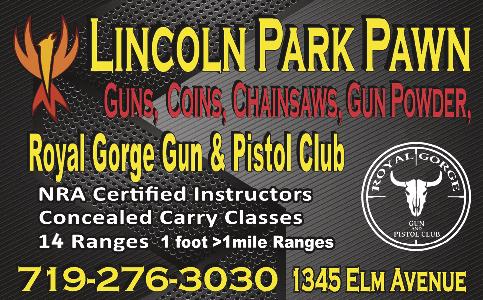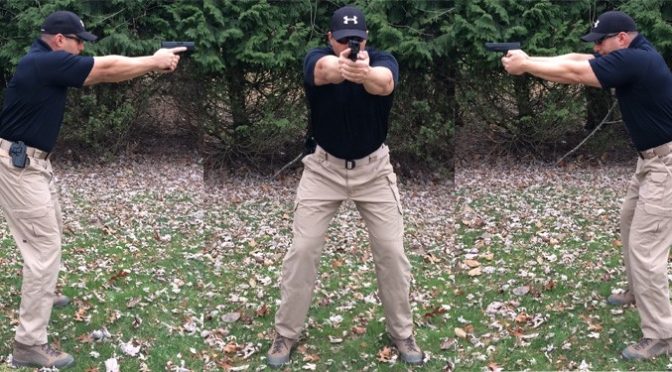Part 1 of 3
by Mark Bunch,
Royal Gorge Gun Club, Lincoln Park Pawn

Hopefully most of you reading this have a basic familiarity with handguns, also known as side arms. In my basic Handgun Training article, a couple of months ago I covered some absolutely critical information for learning to shoot your handgun and for those of you who missed it, I will give a brief recap of the more important things you need to know.
Right or Left Eye
Dominant
If you don’t know this for certain, this is going to be, and likely always has been a huge problem for you when it came to shooting a handgun. With both of your eyes open, extend your right index finger in front of you at arm’s length where the end of your finger covers something up like this light bulb on my ceiling fan.
Once you have done that, take turns closing one eye at a time. If your finger seemingly jumps to the right when you close your right eye, you are in fact right eye dominant, and this is a good thing, an even better thing is if you are also right handed. If you hold your finger out covering the same object with both eyes open and you close your left eye your finger will jump to the left, indicating that you are left eye dominant. This is not the end of the world by any means but to coin one of the only Hollywood Actors to EVER have a clue about what being an American is all about, Clint Eastwood, “A Man’s got to know his limitations”.

If you are left eye dominant and also right handed, that is going to be a little more difficult for you to master combat handgun tactics with. It also likely means that when you were growing up, someone, teacher parent, church clergy likely corrected you from doing things with your left hand and got you accustomed to doing things with your right. I can recall, like over a hundred years ago now, watching some teacher’s aide I believe, going around my kindergarten class correcting left handed students and making them redo everything right handed. I’m here to tell you she was quite the troll and still ranks in my top three all-time troll list, lol. Many times in class I was glad I was right handed watching all of that, as I wasn’t sure I could take her, lol….
If you have correctly determined that you are both right handed and right eye dominant this progression from basic handgun skills to advanced or combat handgun skills is going to be easier to master and I promise I will do my best to explain these techniques taking both skill sets in mind as much as can be accomplished in a mere article.
Shooting position
Everyone has different insets and length of reach and I have seen all sorts of variations of handgun shooting positions over my many years of experience. The key to a good shooting position is consistency, just as in anything in life. My favorite handgun shooting position is what is called the Modified Weaver Stance, with one foot slightly in front of the other, depending on whether you are right or left-handed. Your knees slightly bent with almost a zero forward cant and your weak or support hand bent about 30 to 45%. In both Weaver positions, one hand pushes the handgun the other pulls it back, negating a good portion of the recoil and automatic up and right rotation. In all candor, if you simply squeeze your handgun tightly with both hands that is almost always sufficient to master either of these positions. The big difference between a true Weaver Stance and the Modified Weaver Stance is the strong shooting arm is fully extended and locked out, in the Modified Weaver Stance and in the traditional Weaver Stance, both arms are bent slightly. The Weaver and Modified Weaver are much more stable for you if you happen to be on uneven terrain or if you get attacked as in grabbed or pushed in a struggle.
As a general rule, if you have short stubby arms, you are going to be a better shooter if you use the Isosceles shooting position, where your feet are shoulder width apart, bent slightly at the knees, with a 3 to 7 degree forward cant where you essentially have your handgun centered in your center of mass. This works great whether you are right eye or left eye dominant, and is the most forgiving for you to use if you are left eye dominant and right handed, or vice versa, however, I have never seen a shooter that presented in the reverse just yet..
There are several different schools of thought on this, and if you ask 12 instructors their opinion on the subject, you will likely get 13 different answers. One way to deal with this is to simply close your left dominant eye and aim with your right eye. I know some handgun shooters who are pretty good using this technique but I am sure they would all tell you that it took a long time to master this. I personally try not to advocate this technique as I am not a big believer in closing an eye to do anything. As a male or female of our species, you are blessed and cursed with binocular vision.
Binocular vision has overlapping fields of vision that allow you to focus both of your eyes into one continuous fluid image. Once you close one of your eyes, your overlapping field of vision, especially to the peripheral side of the eye you have chosen to close goes all to h*** and you go zone blind. In the event you have multiple assailants or attackers, do you really want to allow some scumbag to operate in your blind zone because you have to close one of your eyes? For the two of you out there who raised your hands that was an incorrect response, lol. Once you force your binocular apparatus into mono vision you also lose your depth perception and your ability to accurately judge distances which could be critical if you have to move around searching for cover in the middle of the night. I have had a pretty good success rate simply spending time with those students with this paradox and teaching them to shoot lefthanded. For mastering Combat Handgun techniques that you are going to stake the lives of your loved ones and your own on, however, it can be a career ending, ie. your life, decision.
One of the ways to teach yourself out of this predicament is to get a paper silhouette target, tape it on your wall or garage door, with your handgun empty even after you have checked it a couple of times, and practice drawing your firearm and keeping both eyes open. Yes, it is ok to start point blank. Do a couple sets of 10, center mass in the chest and center mass in the head. Once you feel comfortable doing that, back up to three yards or 21 feet.
Once you are good there, move on back, you get the idea. For those of you who swear up and down that your dog is too old for you to learn a new trick, that simply isn’t the case. Do this drill a couple of times per day for a few days, then head to the range and live fire practice on the same paper silhouette target and you will be amazed how you just taught that dumb old dog a new trick after all. As with anything, I suggest for you to do, clear it with management first so you don’t end up sleeping in the doghouse.
For proper holding of your combat handgun there is only one way to do so correctly regardless of what you see on TV or hear from one of your know-it-all friends. With your handgun in your primary hand, place your support hand wrapped into the open area present on the opposite side of your grip with both thumbs along the receiver of your handgun, both pointed in the same direction along your receiver frame, pointed toward your target.
(The author, Mark Bunch is an NRA Certified Law
Enforcement Combat Handgun and Police Firearms
Instructor and has taught over 2,000 students in his career as a Firearms Instructor. He owns and operates his own gun and pawn shop Lincoln Park Pawn with his partner and gun club VP John Hudson and 1 mile gun range in Canon City Colorado. Mark, John, Sam and Myra Smallwood, Jon and Donna Hoff, Bill and Linda Herlth, Mike Konty, Steve Rando, Jock and Pat Harmon and Buddy Moore are also the Fremont County NRA
as well)

